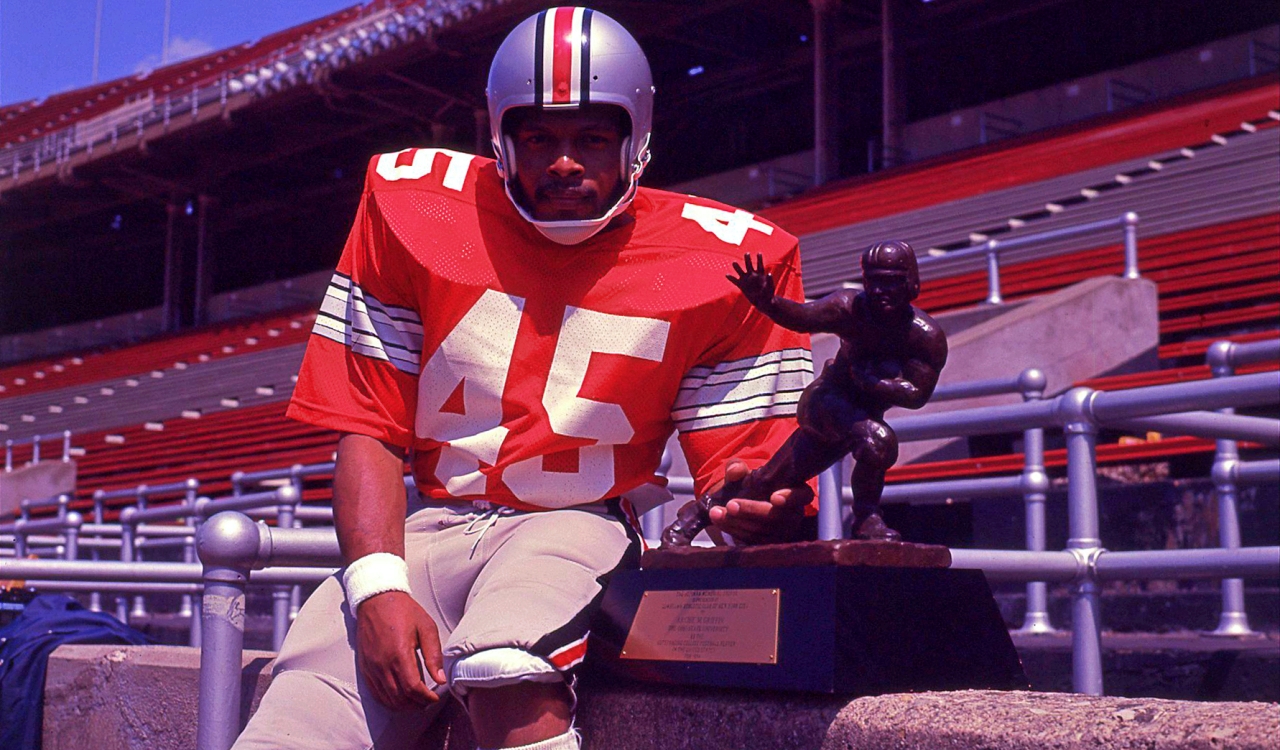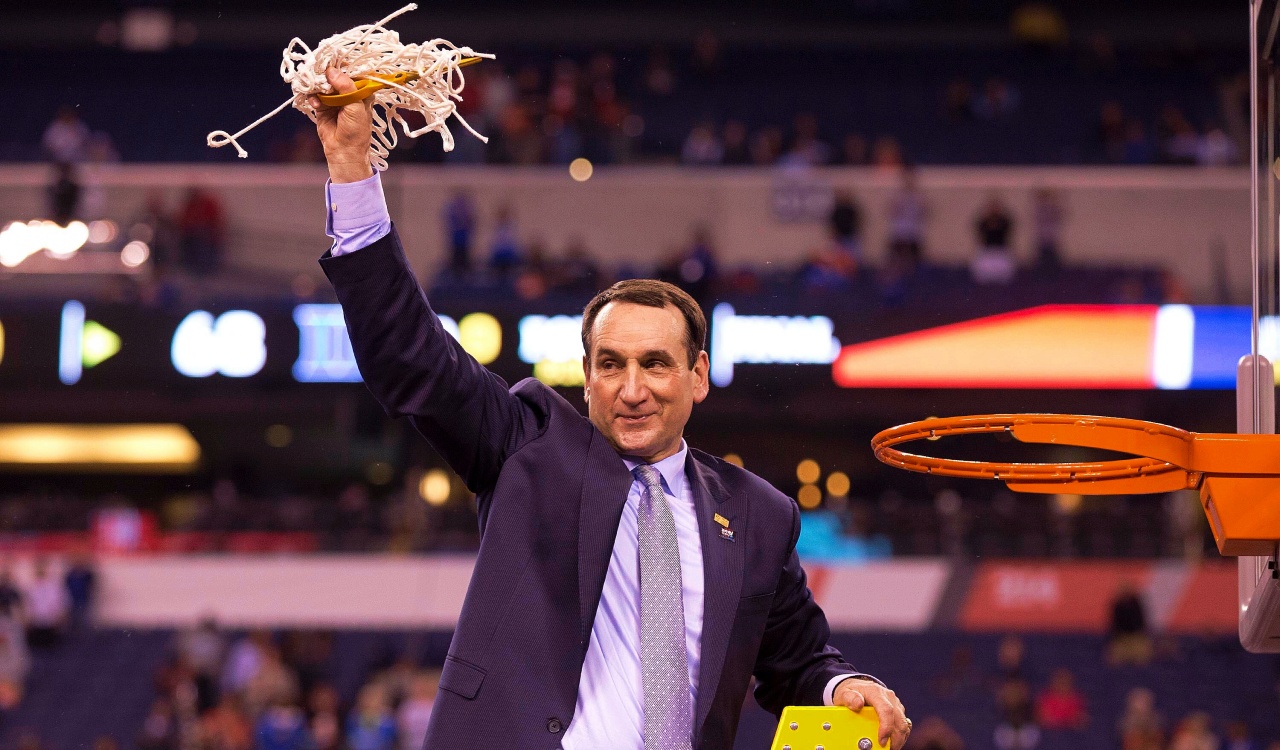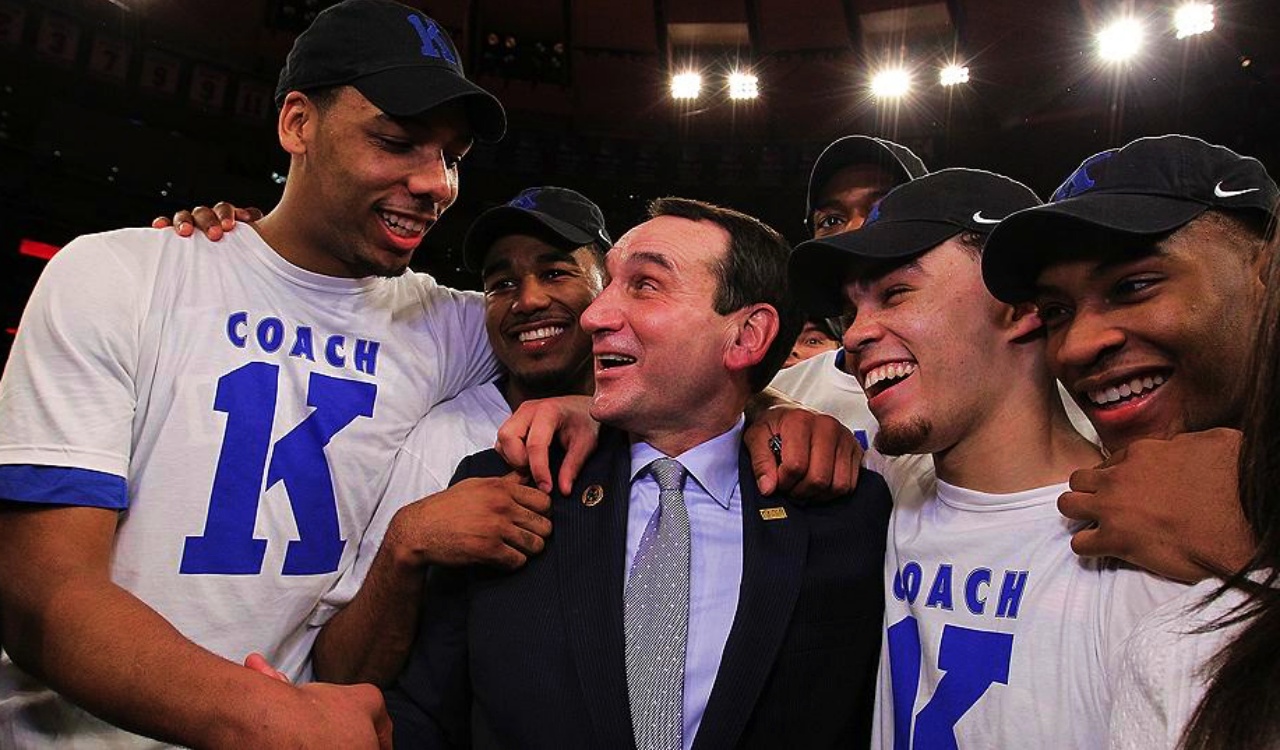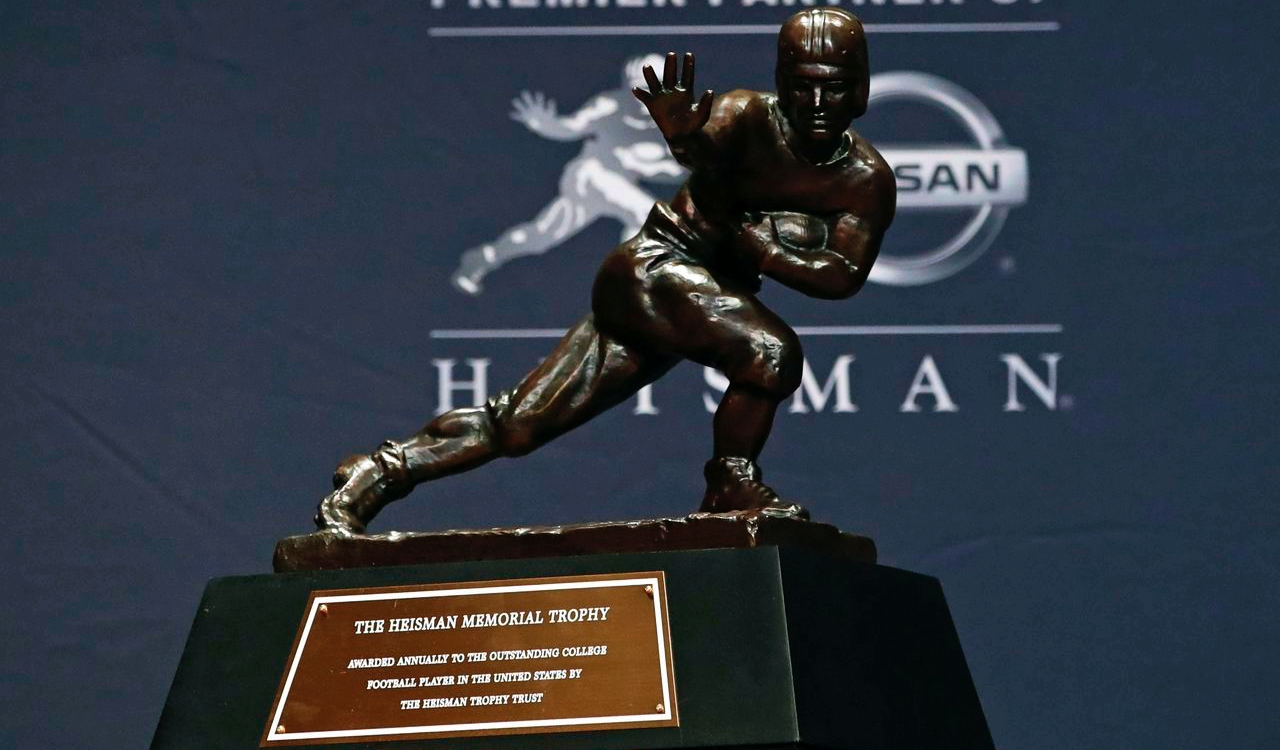While seven of the 10 Heisman winners in the 1970s were running backs, there was still diversity. This includes two quarterbacks and the first wide receiver to ever win the award. This is a very important period in college football. With the nation exiting the racial 50s and 60s, to finally open up opportunities for black men.
NCAA football in the 1970s was mainly dominated by four teams: the University of Nebraska, Notre Dame, Oklahoma, and Alabama, whom each won two national titles in the decade.
1979 also marked Alabama’s last NCAA National Championship (the 6th) under coach Paul “Bear” Bryant. Although, he would coach until 1982.
Other things that happened in the 1970s included:
- The Watergate scandal in 1972-1973.
- The most recent successful moon landing in 1972. The U.S. has not been to the moon since.
- Hank Aaron breaking Babe Ruth’s career home run record of 714 in 1973.
- Richard Nixon becomes the first and still only U.S. President to resign in 1974.
- The Vietnam War ends in 1975.
- Bill Gates founds Microsoft in 1975.
- The first home computer is sold on retail in 1977.
- Star Wars debuts in theatres in 1977. It was sold as a comic six months earlier.
From the professional football side of things, the NFL and AFL successfully completed their merger. The AFL-NFL merger combined the two leagues into one. The league was to have three conferences and three divisions in each conference.
To make this happen, three teams from the original NFL (Baltimore Colts, Pittsburgh Steelers, and Cleveland Browns) agreed to switch to the American Football Conference (AFC). The league agreed to have a 14 game schedule and figure out their own scheduling. This gave us the modern-day NFL.
A lot has happened since, but football forever changed with the merger.
Billy Sims

- Year: 1978
- Heisman Voting: 26.25% of votes
Billy Sims led the NCAA in rushing during his junior year with 1,762 yards for the Oklahoma Sooners. He is now the third of the Heisman winners from the University of Oklahoma as a result. He also rushed for 20 touchdowns and averaged 7.6 yards-per-carry.
In addition to winning the Heisman, he also was named the UPI Player of the Year and also took home the Davey O’Brien Memorial Trophy.
Sims would play one more season with Oklahoma before going pro, where he put yet another Heisman worthy season together. He rushed for over 1,500 yards in his senior season and 22 touchdowns. Sims was named an All-American for the second year in a row due to this.
In 1980, he was drafted number one overall in the NFL Draft by the Detroit Lions. In his first four seasons with the Lions, he played wonderfully.
He was named the UPI NFL-NFC Rookie of the Year and Offensive Rookie of the Year after making the Pro Bowl in his first season. The next season in 1981, he would make it to another Pro Bowl and a First-Team All-Pro team.
Overall, he made three consecutive Pro Bowls when starting off his NFL career.
In his fourth season, he had another great year and rushed for over 1,000 yards for the third time in four years. Yet this was the last major season for Billy. During his fifth season, Sims suffered a devastating knee injury that eventually forced him to retire.
His accomplishments are solidified in history though. He is a part of the Oklahoma Hall of Fame (inducted in 1994), as well as the College Football Hall of Fame (inducted in 1995).
John Cappelletti

- Year: 1973
- Heisman Voting: 32.78% of votes
John Cappelletti led the Penn State Nittany Lions to a perfect 12-0 season on his way to a Heisman Trophy. To this day, out of all the Heisman winners that have ever been, Cappelletti is the only one from Penn State.
He certainly deserved it though, as he rushed for 1,522 yards and 17 touchdowns while averaging 5.3 yards-per-carry.
This great season came just two years after Cappelletti’s position switch following his Sophomore season. In his first two years of college football, he actually played as a defensive back.
In 1972, after his position switch, he rushed for 1,117 yards and 12 touchdowns. Penn State finished with a 10-2 record and finished as the 10th best team in the nation.
In 1973, during Cappelletti’s Heisman winning campaign, the Nittany Lions improved heavily. They finished with an 11-0 regular-season record. They even dominated their rivals Syracuse, West Virginia, Maryland, and Pittsburg by a combined score of 188-55. Then they beat 13th-ranked LSU in the Orange Bowl to finish as the 5th-ranked team in the nation.
Cappelletti also won the Maxwell Award, Walter Camp Award, and was named an All-American along with the UPI College Football Player of the Year.
He was then drafted number 11 overall in the 1974 NFL Draft by the Los Angeles Rams. Cappelletti played a total of nine seasons in the NFL between the Rams and San Diego Chargers before retiring in 1983.
Cappelletti is a member of the National Italian American Sports Hall of Fame and the College Football Hall of Fame (inducted in 1993).
His college number (22) is the first and only number in any sport that has been retired by Penn State.
Johnny Rodgers

- Year: 1972
- Heisman Voting: 38.75% of votes
Johnny “the Jet” Rodgers became the first wide receiver to win the Heisman Trophy when he won it in 1972. He was the first of the University of Nebraska’s Heisman winners. Since Rodgers, two others have won the award
The Cornhuskers wide-out caught 58 passes for 1,013 yards and nine touchdowns, with an average of 17.5 yards per catch. He also picked up 348 rushing yards and an additional 10 touchdowns on the ground.
Rodgers came to Nebraska in 1970, where he helped lead them to three-consecutive Orange Bowl victories and two NCAA National Championships in his college career.
With Rodgers on their side, the Cornhuskers sported 33-2-2 record during his time with the team.
After college, he was taken as the number 25 overall selection in the 1973 NFL Draft by the San Deigo Chargers. Instead of playing in the NFL, however, he decided to sign with the CFL.
In his four seasons in the CFL, he was amazing. He won the CFL Most Outstanding Rookie Award, the Jeff Russel Memorial Trophy twice, and was a three-time CFL All-Star as well as a Grey Cup Champion.
In 1977, he signed with the Chargers in the NFL and caught four touchdowns in two seasons. While he did not accomplish much in the NFL, his career in the CFL and time in college was legendary.
In 1999, Rodgers was inducted into the National Football Foundation Hall of Fame, as well as the College Football Hall of Fame in 2000.
Pat Sullivan

- Year: 1971
- Heisman Voting: 42.25% of votes
Pat Sullivan threw his way into the record books en route to becoming the first of Auburn University’s Heisman winners, in 1971.
It made sense to see Sullivan have a terrific season in 1971, as a year prior he had a terrific season too. He passed for 2,586 yards and 17 touchdowns, led the Tigers to a 9-2 season, and finished sixth in the Heisman race.
In 1971 he was nearly identical. He passed for 2,262 yards and 21 touchdowns and once again led the Tigers to a 9-2 record. Except for this time his efforts were good enough to win the Heisman Trophy.
Other accomplishments he had while in college included:
- Breaking the NCAA record for yards per play with 8.57 in 1970
- Tieing the NCAA record with 72 total career touchdowns
- Winning the MVP in the Senior Bowl game in1971
- Capturing the Sammy Baugh Trophy in 1970
- Winning the SEC Player of the Year Award in 1970
- Consensus All-American in 1971
- Walter Camp Player of the Year Award in 1971
After college ball, Sulivan was selected by the Atlanta Falcons in the 1972 NFL Draft. He played six seasons in the NFL before beginning his business, commentating, and coaching career.
From 1986-2014, he helped coach for Auburn, TCU, University of Alabama Birmingham (UAB), and Samford. In 1994, he was named the Southwest Conference (SWC) Coach of the Year. Then in 2012, he was named the Southern Conference (SoCon) Coach of the Year.
His college number (7) was eventually retired by Auburn. Yet in 1991, he was inducted into the College Football Hall of Fame as a player.
Earl Campbell

- Year: 1977
- Heisman Voting: 49.11% of votes
Earl Campbell simply out-manned his way to a Heisman Trophy in 1977. He was the first of the University of Texas’ Heisman winners as a result, an honor that had eluded the great school for years prior. He led the Texas Longhorns to an 11-1 season in ’77, which saw them finish as the fourth-best team in the country.
Campbell rushed for a school-record 1,744 yards and 18 touchdowns while averaging 6.5 yards-per-carry, and leading the nation in rushing.
As a four-year starter for the Longhorns, he finished his college career with 4,443 rushing yards and 41 touchdowns. Both were school records at the time. It was also unheard of to see such dominance all four years too.
He then went on to play for the Houston Oilers, after he was drafted number one overall in the 1978 NFL Draft. In his first three seasons, he already established himself as one of the best backs in NFL history. By the time his career came to a close, he was guaranteed to become a Hall of Famer.
Campbell made it to five Pro Bowls, three First-Team All-Pro teams, and was a three-time Offensive Player of the Year award winner.
His professional number (34) is retired by the now Tennesee Titans (formerly the Oilers). Not to be outdone, his college number (20) was also retired by the Longhorns.
He also is part of the NFL 1970s All-Decade Team and NFL 100th Anniversary All-Time team.
Campbell was inducted into the College Football Hall of Fame in 1990 due to his impressive college play. Yet in 1991, he was inducted into the Pro Football Hall of Fame due to his brilliance at the professional level.
Charles White

- Year: 1979
- Heisman Voting: 53.81% of votes
Charles White rushed for 2,050 yards in 1979 to capture the Heisman Trophy, becoming the third of the University of Southern California’s Heisman winners.
He also accumulated 19 touchdowns and 145 receiving yards. His efforts helped lead USC to an 11-0-1 season, including a Rose Bowl victory over Ohio State to close off their season. They even won the Pac-10 Conference Championship and finished as the second-best team in the country.
White finished his college career with 6,245 rushing yards, which was the second-most in NCAA history at the time.
After winning the Heisman, he was taken as the number 27 overall pick in the 1980 NFL Draft by the Cleveland Browns. He played in the NFL until 1988. While having just a mediocre career in the pros, he did have some flashes of greatness, like his 1987 season.
That season he led the NFL in rushing, won the NFL Comeback Player of the Year Award, made it to the Pro Bowl, and was named First-Team All-Pro. White finished his NFL career with 3,079 rushing yards and 24 touchdowns.
Since his playing days, he has made three appearances on the TV show American Gladiators. He was also a running backs coach at USC for a short time. However, he now works as a computer consultant.
Another interesting fact is that in high school he competed against and beat future Gold Medalist Andre Phillips in the 330 yard low hurdles event.
Due to his impressive college career, White was inducted into the College Football Hall of Fame in 1996.
Archie Griffin

- Year: 1975
- Heisman Voting: 57.64% of votes
Our next player is perhaps the most interesting subject on this list series. Archie Griffin is the only player to ever win back-to-back Heisman Trophies. This uniquely made him both the fourth and fifth of Ohio State University’s Heisman winners.
First, we will focus on his second Heisman victory in 1975.
He rushed for 1,450 yards and four touchdowns while picking up another 170 receiving yards for the Buckeyes. He led OSU to an 8-0 season which saw them finish as the fourth-best team in the nation.
They beat five ranked teams en route to a conference championship. This included stud teams of the time in Michigan, Michigan State, Penn State, and UCLA.
Following the season, he was selected as the 24th overall pick in the 1976 NFL Draft by the Cincinnati Bengals. Griffin played with the Bengals in the NFL for seven years before retiring. He rushed for over 2,000 yards and picked up seven touchdowns in his NFL career.
An interesting fact about his time in the NFL is that he played alongside his college teammates Pete Johnson and Ray Griffin, the latter of which is his brother.
In 1986 he was inducted into the College Football Hall of Fame. Very few men could be more deserving.
Jim Plunkett

- Year: 1970
- Heisman Voting: 58.78% of votes
Out of all the Heisman winners that have ever been, Jim Plunkett is the first and only one from Stanford University. Several have come close but only Plunkett has reached the mountain top for the Cardinal.
He passed for 2,980 yards and 19 touchdowns, leading the Cardinal to a 9-3 record. They also won the Pac-8 Conference Championship and the Rose Bowl en route to helping the team finish as the 10th best team in the nation.
He also won the Maxwell Award, Walter Camp Award, Sporting News Player of the Year, UPI Player of the Year, and was a Consensus All-American.
In 1971, he was selected number one overall pick in the NFL Draft by the New England Patriots. Of course, as we know, Plunkett had a ton of success at the pro level.
Plunkett won the AFC Rookie of the Year Award in 1971, the NFL Comeback Player of the Year Award in 1980, and was a won Super Bowl’s XV and XVIII. He was also the MVP of Super Bowl Bowl XV.
He was later inducted into the College Football Hall of Fame in 1990. Out of all eligible players, Plunkett is still the only Quarterback to start two Super Bowls, win them, and not be inducted into the Pro Football Hall of Fame.
Archie Griffin

- Year: 1974
- Heisman Voting: 59.53% of votes
While it is known that Archie Griffin was the first two-time Heisman winner, most people don’t know that he actually finished in the top five three times. During his Sophomore season, just a year prior to winning his first Heisman Trophy, he finished fifth in Heisman voting.
Back to his junior season, however, he led the Buckeyes to yet another Rose Bowl game. He rushed for 1,695 yards and 12 touchdowns while averaging 6.6 yards-per-carry.
The Buckeyes went 10-2 and finished as the fourth-best team in the nation. Their offense soared, scoring 30 or more points on eight different occasions.
Following Griffin’s second Heisman Trophy in 1975, he had the NCAA record for career rushing yards with 5,589. Also, between his sophomore and senior seasons, he rushed for 100+ yards in 31 consecutive games, which is still an NCAA record.
After his professional playing career, he was the Assistant Athletic Director at Ohio State. On top of this, he was also the former President of “THE” Ohio State University Alumni Association.
As of today, one of his kids a high school football coach and the other played football at Ohio State before getting injured. In today’s era of play, Archie is still seen as one of the best Heisman winners in history, while he might perhaps be the best for some.
Tony Dorsett

- Year: 1976
- Heisman Voting: 74.97% of votes
Tony Dorsett was the first player from the University of Pittsburgh to win the Heisman Trophy. To this day, out of all Heisman winners, Dorsett is the only one the University of Pittsburgh has produced
After finishing fourth in Heisman voting in 1975, he proved there was no doubt he should win in 1976.
He rushed for 2,150 yards and 22 touchdowns to lead the Panthers to a perfect 12-0 season that concluded with an NCAA Championship victory. This came just four years after the Panthers finished a season 1-10.
Dorsett made history by ending his college career with 6,526 rushing yards, which was an NCAA record. He set or tied 18 NCAA records during his time as a player, which is more than any other player in NCAA football history.
He’d later go on to be drafted as the number two overall selection in the 1977 NFL Draft by the Dallas Cowboys. As we all know, Dorsett had a terrific professional career. He was named to the Pro Bowl four times and even won a Super Bowl. He finished his pro career with 12,739 yards rushing and 77 touchdowns. The career yards still rank in the top ten most in NFL history.
He played in the NFL until 1988, and after retiring from the game he became part of the Dallas Cowboys Ring of Honor.
Dorsett has also been a member of the College Football Hall of Fame and the Pro Football Hall of Fame since 1994.



